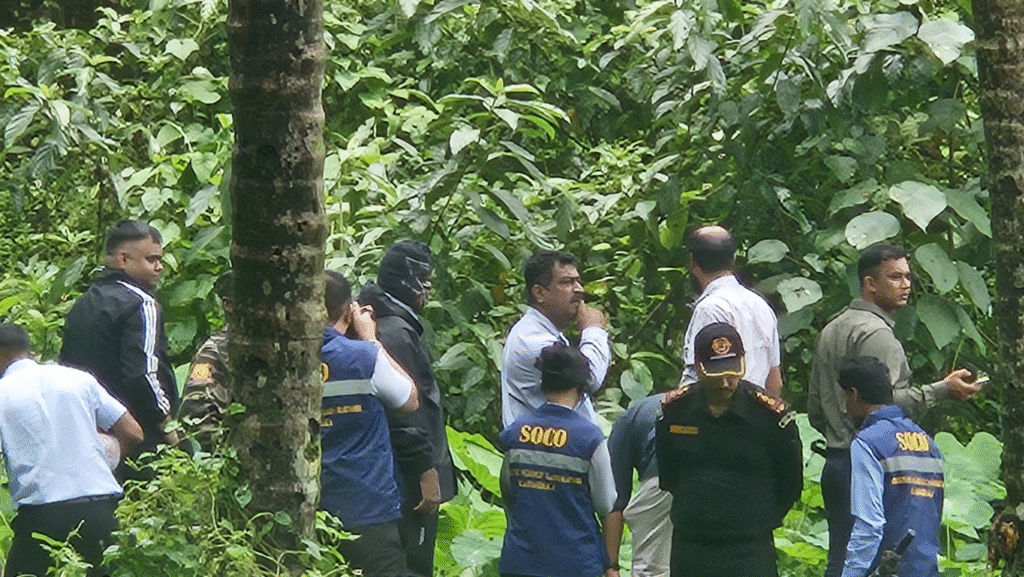In a major breakthrough in the Dharmasthala mass burial case, partial skeletal remains have been recovered from the sixth site, lending credibility to a former sanitation worker’s explosive allegations. Get full details of the SIT investigation, forensic findings, and what lies ahead.
In a shocking turn of events in the ongoing Dharmasthala mass burial Case investigation, the Special Investigation Team (SIT) has unearthed partial skeletal remains from the sixth identified site. This marks the first physical evidence recovered in a case that has drawn nationwide attention due to its deeply disturbing nature and serious allegations involving decades-old unsolved deaths.

According to sources close to the SIT, the remains are believed to belong to a male and are in a highly decayed state. The discovery is being hailed as a major breakthrough in a case that was, until now, solely based on the explosive testimony of a former sanitation worker turned whistleblower.
First Evidence Amid High-Stakes Allegations
The case gained momentum when the whistleblower came forward alleging that he was forced to bury and cremate bodies—including women and minors allegedly showing signs of sexual assault—between 1998 and 2014. These burials were said to have taken place at multiple secret locations across the temple town of Dharmasthala.
He identified 15 suspected sites, prompting the formation of a Special Investigation Team and a large-scale search operation, supported by forensic experts, local authorities, and police personnel.
Sixth Site Reveals Human Remains
The skeletal remains were recovered during an exhumation operation at site number 6, where the whistleblower had specifically pointed out the burial of two bodies. Although the first five sites yielded no trace of human remains, the discovery at the sixth site has given fresh momentum to the case.
A dog squad was deployed to aid in the search, and forensic teams were quick to secure the remains for detailed laboratory analysis. Sources said digging operations were expanded, considering that time and environmental factors may have scattered the skeletal parts.
Items Recovered with the Remains
Investigators also recovered various materials from the location, including:
- Pieces of rope
- Torn clothing
- A damaged printer
- An old laptop
These items have been catalogued as potential evidence, and their relevance will be determined following forensic analysis. Experts believe these non-human items may offer clues about the identity of the victim(s) or the context of the alleged crimes.
Mapping the 15 Suspected Sites
Out of the 15 locations named by the whistleblower:
- 8 sites are situated along the Nethravathi River
- Sites 9 to 12 are located beside the highway near the river
- The 13th site lies on the road from Nethravathi to Aajukuri
- The last two sites are found in the Kanyadi area near the main highway
Investigators are expected to continue exhumation and digging activities at all these locations in the coming days. The whistleblower has been assisting with on-site identification and verification.
Police and Forensic Experts Cautiously Optimistic
Senior SIT officials said the discovery of the skeletal remains marks a turning point in the investigation.
“We are proceeding with extreme caution. The skeletal remains will undergo thorough forensic and DNA testing to establish identity, age, and time of death. If confirmed, this could corroborate at least part of the whistleblower’s claims,” said an SIT member.
So far, no arrests have been made, and the identities of potential suspects remain under wraps. However, with the first piece of physical evidence now in hand, authorities are reportedly drawing up a list of individuals who may be summoned for questioning.
Public Outrage and Demand for Transparency
The Dharmasthala mass burial case has stirred public outrage, with human rights groups and political leaders demanding a transparent, fast-tracked probe. The local administration has assured complete cooperation with the SIT.
Citizens in the temple town, known for its spiritual and cultural significance, remain in shock as more details emerge.
What Happens Next?
The forensic analysis of the recovered skeletal remains is now a critical step in this high-profile investigation. Depending on the results, the SIT may intensify searches at the remaining sites and launch criminal proceedings if credible links to unlawful activity are established.
For now, the Dharmasthala case remains a complex and evolving story. But one thing is clear: the first physical evidence has transformed it from allegation to potentially verifiable reality.
